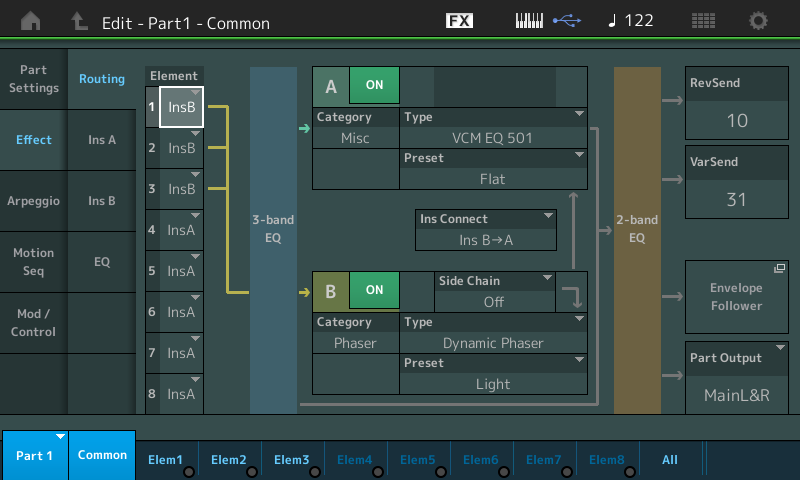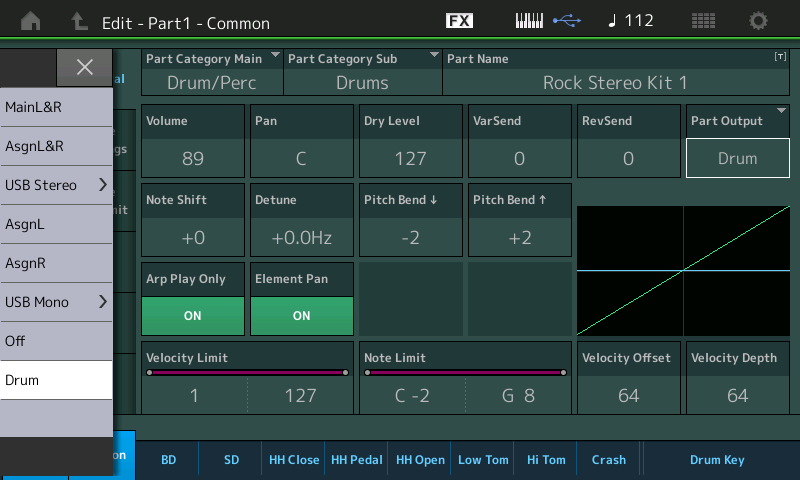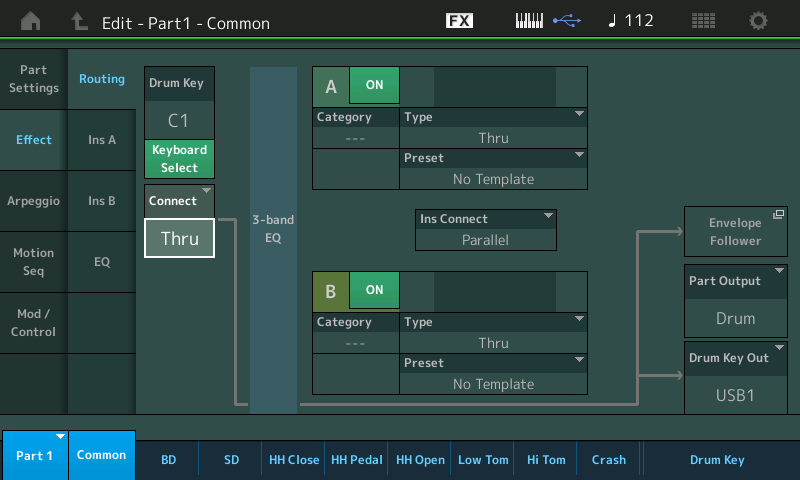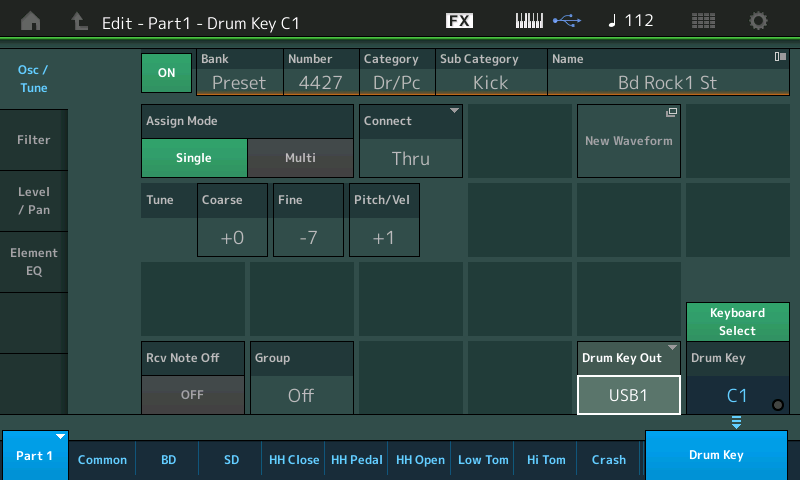Hi guys,
From the manual and the discussions on this forum it is clear that the MODX has 10 USB audio out channels over which I can route parts to Cubase for recording. I have tried doing this with each part as stereo - routed over USB1&2, USB2&3, USB3&4, USB5&6 and USB 7&8 - which allows 5 parts at a time. Now, I tried one recording where I tried doing the exact same thing, but with each part as mono. This means I could transfer 10 audio tracks simultaneously. When I tried this, things did not go as expected. I found the levels were a lot lower, and each part was very "dry". I'm not sure if I did something wrong, and I lost something while sending the parts as mono. At first glance it seemed to me that if I use mono, I am losing some system effect maybe? What is the recommended way to do this? I'm sure I am missing something because Yamaha would not have designed a 10 channel audio interface which works only as 5-channel in stereo! In particular, I was also interested in separating my drum track into kick, snare, toms and high-hats for better mixing in Cubase. That would take up 4 channels, leaving just one more stereo channel. So I am really interested in exploring the 10 mono channel approach a bit more. Any pointers?
From the manual and the discussions on this forum it is clear that the MODX has 10 USB audio out channels over which I can route parts to Cubase for recording. I have tried doing this with each part as stereo - routed over USB1&2, USB2&3, USB3&4, USB5&6 and USB 7&8 - which allows 5 parts at a time.
Excellent. But let me straighten out the Outputs. There are 10, true. And that is 5 Stereo pairs... but it’s the Main USB L/R plus 4 pairs of numbered Outputs; USB 1/2, USB 3/4, USB 5/6 and USB 7/8.
_ The Main (USB) L/R Output is the default assignment for all 16 Parts.
The MODX works exactly like a professional mixing console. When a Channel is routed to the Main Stereo Outputs it can use the System Effects via a Send control. On a console you may have two Aux Sends... these allow each channel to Send a portion of its signal to the Studio’s shared Effects... the first Aux feeds the “Reverb”; the second Aux feeds the “Variation” Effect.

Every Part can Send signal into these effects... think of the Reverb Chamber as a ‘shared’ effect... all the instruments are in the same room. The System Effects recreate the outer environment, in which the music takes place. The Return from these shared System Effects, is mixed back into the main flow just prior to the Main L/R Output.
_ Just like on a mixing console, you can opt to route any channel to a direct Out. This removes the signal BEFORE the Aux Sends... this means you are removing (separating) the signal from the group and you are going to put it on a separate bus. This bus routes the signal on a different path... to one of the USB numbered Outputs. (A bus is a vehicle that can carry one or more passengers from a source to a destination along a specific route) in this case, the passenger is an audio signal, and the route is to a discreet numbered USB Output (which you can feed to its own Audio Track)
So if you take Part 1 and set the “Part Output” = USB 1/2 it will be removed from the main stereo group, and is re-routed to USB 1/2. It no longer feeds the Aux Sends for Reverb or Variation Effects. It does, however, maintain its two Insertion Effects.

The Insertion Effects are intricately woven into the instrument sound itself. They are very much the *personal* effects of that instrument. The Insertion Effects are the ones under control of the player. Above, the three Elements of Part 1 are being routed, first through the 3-band EQ; Then to Insertion B (Dynamic Phaser) > Insertion A (VCM EQ 501) > the 2-band EQ > you can see that the signal can be routed to the “Part Output” - when you change that from “Main L/Rl to “USB 1/2” notice how the option to go to the Rev an Variation Send disappear. You are removing the signal from the main mix and touting it to the direct out.
A Guitar Part might have a Distortion and a Wah-Wah pedal, these are the Guitar’s effects alone. No one else is plugged into them. The guitar Part’s Oscillators are routed through a 3-band EQ, then to the INSERTION Block A and B, then to a 2-band EQ, and then to the USB 1/2 bus Output. You can assign physical Controllers (like an FC7 as Wah) to “work” these Insertion Effects in real-time. The organ Part might have an Overdrive and a Rotary Speaker effect as its two Insertion Effects... you can assign the MW to change the rotary speaker speed in real-time.. it’s the organ’s personal effect.
So your isolated Parts go to the USB numbered Output with their Insertion Effects in tact... and are removed from the System and Master Effects.
Important takeaway: The 5 sets of stereo Outputs are identical EXCEPT that the Main L/R pair include the System Effects, and the Master Effects. (You can Bypass these, making them exactly like the numbered USB pairs). The numbered USB Outputs are always setup in Odd/Even pairing... where the Odd number is left and the Even number is the right channel.
Now, I tried one recording where I tried doing the exact same thing, but with each part as mono. This means I could transfer 10 audio tracks simultaneously. When I tried this, things did not go as expected. I found the levels were a lot lower, and each part was very "dry". I'm not sure if I did something wrong, and I lost something while sending the parts as mono. At first glance it seemed to me that if I use mono, I am losing some system effect maybe?
If you are unaware of what happens - it can cause some head scratching... this is guaranteed. Here’s what you need to know, to get started.
If you take a stereo instrument Part and route it on a Mono bus, you are going to downgrade the sound quality. You will notice it, immediately.
How this can happen — say you have a lead synth sound... seems like a perfect candidate for a Mono bus... it is not like it was sampled in stereo like most of the acoustic pianos, many of the string orchestra and brass orchestra sound... BUT... what if the synth lead sound is using a “Tempo Stereo Delay” as one of its two Insertion Effects? Well, if you attempt to *squeeze* this into a mono bus, trust me the sound will suffer and you will immediately know it.
The Part routed to a numbered USB Out is always “Dry”, as concerns the studio’s shared System Effects (Reverb, Variation), and Master Effects. But it goes to the numbered USB OUT with both of its personal effects (the Insertion A and B Effects). They are apart of the instrument.
Study each Part... check out what is going on with its Insertion Effects... make a decision about whether you should be preserving the stereo or is it truly a candidate for a Mono bus?
Typically, Bass is a big time candidate for Mono. Here’s why... traditionally, Bass found its way to the very center of the stereo field for practical reasons. When stereo first became the rage in the late 1950 and early 1960s, you found records where there was S-E-P-A-R-A-T-I-O-N, I mean drums in one speaker, bass in another, the lead instrument separate from accompaniment. Listen to old classic stuff like Dave Brubeck “Take Five” or check any Jimmy Smith record... the organ trio would be drums in one speaker, the guitar in the opposite speaker, and the organ in the the middle (both). Or “Dance to the Music” by Sly and the Family Stone... or the old Beatles stuff (4 tracks)
But as dance music (mainly disco from the 70’s) and pop music demanded more and more thump from the low end, you had to put the bass in the center (so it came equally out of both speakers) if you didn’t, when they cut the vinyl record, one of the grooves walls would be significantly higher than the other, and the stylus would not track. It would either slide toward the spindle in center or never be able to play at all, the stylus would jump off the record. So with vinyl, you put all your low frequency THUMP in the center — out of necessity... it’s now like a standard, because it works and/or we’ve gotten so used to it.
Anyway... Bass, if it has any effects they are typically mono. But there are exceptions to every mixing rule. Sometimes stereo bass is so different it becomes compelling... try anything see if you like it. Larry Graham, with Sly and the Family Stone had two big Acoustic Bass amps, one with the Fuzz on the other clean... one left side, the other in the right side; that sound was like a big thing (Dance to the Music) drums in the left channel, organ far right, horns left..
Drum Kit Routing
I digress... the way the Mono buses really come in handy, is when you need to record separate audio stems for the Kick drum, Snare Drum, Hihats, etc. each Drum Key can be routed to a numbered USB bus. (You route only the ones you are using). When you set the Drum Kit “Part Output” = Drum, this tells the system that you want to isolate some of the Drum Keys to their own discreet Output.

When you drop in to Edit on a Drum Kit Part > tap “Drum Key” > you can use the Keyboard Select options in the lower right corner to recall a drum Key by touching the Keyboard. Each Key is autonomous and can be routed as you desire. The Key becomes available for assignment to a USB bus Output when you set “Connect” = Thru

When “Connect” = Thru, you will see “Drum Key Out” appear in the lower right corner.
For example:
Kick to USB 1
Snare to USB 2
Hihat Closed, Pedal and Open all to USB 3
Crash Cumbal to USB 4
Your Tom-Tom’s to a stereo pair USB 5/6 (to mani train the panning as you go around the Kit from high Tom to floor Tom

Remember, when rendering Audio, you can take multiple passes. You can reconfigure Output assignments, you can reallocate Effects, take your time.
Often if you have done pre-production with your MODX or MONTAGE, you may go to the recording studio and transfer your data to Audio with discreet Audio Tracks for each Part. Some times you need a separate track for each of the principal drum sounds, etc. If you are a jingle writer, the production team may require you submit complete separate audio recordings (stems) of each significant Part (they may wish to ‘over produce’ your work... as a jingle writer you just deliver the tracks, get paid, and move on (lol).
Often on a pop tune, you want to use some computer based plug-ins to enhance the sounds you are using in the internal. You might want to send the Kick drum to a Cubase plug-in like the “Envelope Shaper”.
Again, I must warn you, the additional outputs makes it look tantalizing - LIKE I’m going to save time transferring my stuff to Audio in my DAW... until you really start to use it. That’s when you discover that it opens the door to so many creative possibilities, that you had not even thought of previously. When you start Side Chaining Parts, and have one Part interact with other Parts... or you start using the Motion Sequencer to *automate* parameter changes... there are things that you can do with the Motion Sequencer that can only be captured as Audio.
Taking separate outputs, after all, is something you do when you want to take advantage of some of the processing available to you in today’s Daw software.
It would be a mistake to simply assign a Part to a Mono bus without studying what makes it work. Is it using the stereo field to do what it does? If the Insertion Effect is Stereo, it will make a difference. You can either reprogram it, or setup to capture the stereo.
Thanks for the detailed reply, Bad Mister! Your digressions are a very interesting read - I had never heard of Dave Brubeck's Take Five, and started listening on Spotify. That's one catchy tune! 
I do see now what may have gone wrong when I tried to change the part outputs to mono. This makes sense, and thanks for the detailed tips on drum kit routing. This is what I wanted to try, and armed with this knowledge, my work becomes easier!
